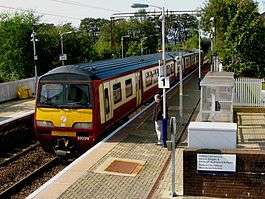Bowling railway station
| Bowling | |
|---|---|
| Scottish Gaelic: Bolan[1] | |
 | |
| Location | |
| Place | Bowling |
| Local authority | West Dunbartonshire |
| Coordinates | 55°55′52″N 4°29′34″W / 55.9311°N 4.4929°WCoordinates: 55°55′52″N 4°29′34″W / 55.9311°N 4.4929°W |
| Grid reference | NS442736 |
| Operations | |
| Station code | BWG |
| Managed by | Abellio ScotRail |
| Number of platforms | 2 |
|
Live arrivals/departures, station information and onward connections from National Rail Enquiries | |
| Annual rail passenger usage* | |
| 2012/13 |
|
| 2013/14 |
|
| 2014/15 |
|
| 2015/16 |
|
| 2016/17 |
|
| Passenger Transport Executive | |
| PTE | SPT |
| History | |
| Original company | Caledonian and Dunbartonshire Junction Railway |
| Pre-grouping | CR and NBR |
| Post-grouping | LMS and LNER |
| 31 May 1858[2] | Opened |
| National Rail – UK railway stations | |
| * Annual estimated passenger usage based on sales of tickets in stated financial year(s) which end or originate at Bowling from Office of Rail and Road statistics. Methodology may vary year on year. | |
|
| |
Bowling railway station serves the village of Bowling in the West Dunbartonshire region of Scotland. This station is on the North Clyde Line, 12¼ miles (20 km) west of Glasgow Queen Street.
The station is managed by Abellio ScotRail who also provide the train service. It was opened in 1858 by the Glasgow, Dumbarton and Helensburgh Railway, though Bowling had received its first railway several years earlier courtesy of the Caledonian and Dumbartonshire Junction Railway (whose Bowling Pier terminal linked into the steamer service along the River Clyde).
The station was made famous by a 1960 painting by the renowned railway artist, the late Terence Cuneo, who depicted a then new Blue train (Class 303) heading westbound into Bowling, passing a steam engine, which the 303 had replaced, in a siding. The painting was used as a poster 'Glasgow Electric'[3].
Accidents and incidents
On 8 September 1933, a passenger train collided with wagons on the line due to a signalman's error. Five people were injured.[4]
Services
2006/07
There is a daily half-hourly service eastbound to Glasgow Queen Street and beyond (usually Airdrie) and westbound to Balloch.
2010/11
There is a daily half-hourly service eastbound to Glasgow Queen Street and Airdrie (including one direct service to Edinburgh Waverley in the morning) and westbound to Balloch.[5]
During the operation of the interim timetable until sufficient Class 380s had entered service, the eastbound service terminated at Airdrie.[6]
2016
The service remains half hourly in the May 2016 timetable but on weekdays and Saturdays, westbound trains now end at Dumbarton Central and eastbound trains run to Cumbernauld via Clydebank. Sunday services run half-hourly to Balloch and to Glasgow Central Low Level (and thence alternately to Motherwell via Whifflet and to Larkhall).[7]
| Preceding station | Following station | |||
|---|---|---|---|---|
| Kilpatrick | Abellio ScotRail North Clyde Line |
Dumbarton East | ||
| Historical railways | ||||
| Kilpatrick Line and station open |
North British Railway Glasgow, Dumbarton and Helensburgh Railway |
Line continues as C&DJR | ||
| Line continues as GD&HR | Caledonian & North British Railway Caledonian and Dunbartonshire Junction Railway |
Dumbarton Central Line closed; Station open | ||
References
Notes
- ↑ Brailsford 2017, Gaelic/English Station Index.
- ↑ Butt 1995, p. 41.
- ↑ Science Museum http://collection.sciencemuseum.org.uk/objects/co228546/glasgow-electric-poster
- ↑ Hoole, Ken (1983). Trains in Trouble: Vol. 4. Truro: Atlantic Books. p. 19. ISBN 0-906899-07-9.
- ↑ "National Rail Timetable 226; December 2010" (PDF). Retrieved 17 November 2010.
- ↑ "Interim timetable: Edinburgh to/from Helensburgh MONDAY TO FRIDAY Service" (PDF). Retrieved 3 January 2011.
- ↑ Table 225 & 226 National Rail timetable, May 2016
Sources
| Wikimedia Commons has media related to Bowling railway station. |
- Brailsford, Martyn, ed. (December 2017) [1987]. Railway Track Diagrams 1: Scotland & Isle of Man (6th ed.). Frome: Trackmaps. ISBN 978-0-9549866-9-8.
- Butt, R. V. J. (1995). The Directory of Railway Stations: details every public and private passenger station, halt, platform and stopping place, past and present (1st ed.). Sparkford: Patrick Stephens Ltd. ISBN 978-1-85260-508-7. OCLC 60251199.
- Jowett, Alan (March 1989). Jowett's Railway Atlas of Great Britain and Ireland: From Pre-Grouping to the Present Day (1st ed.). Sparkford: Patrick Stephens Ltd. ISBN 978-1-85260-086-0. OCLC 22311137.
External links